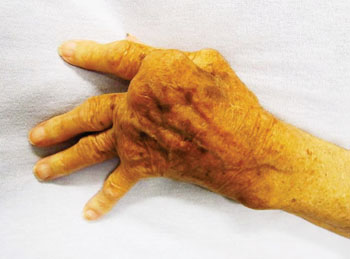Blood Test Aids Early Detection of Rheumatoid Arthritis
By LabMedica International staff writers
Posted on 10 Mar 2015
A blood test that measures the levels of a certain protein can be used in conjunction with clinical assessments to assist with the diagnosis of rheumatoid arthritis is now available in North America.Posted on 10 Mar 2015
Rheumatoid arthritis (RA) is a chronic, systemic inflammatory disorder that primarily affects joints and it may result in deformed and painful joints, which can lead to loss of function. The disease may also have signs and symptoms in organs other than joints.

Image: Severe rheumatoid arthritis in a hand which was never treated (Photo courtesy of James Heilman, MD).
The JOINTstat test (Augurex Life Science; Vancouver, BC, Canada) measures 14-3-3η (eta), a protein involved in joint damage that leads to debilitation in patients with RA, a disease that affects one out of every 100 Canadians. High levels of 14-3-3η protein indicate that the patient should be referred to a rheumatologist. JOINTstat has been evaluated in clinical studies in over 3,000 patients and has been available in the USA since late 2013.
Extracellular 14-3-3η protein is a potent ligand and activator of intracellular signaling pathways that lead to the upregulation of inflammation and joint damage factors involved in RA pathogenesis. A quantitative enzyme-linked immunosorbent assay is used to assess 14-3-3η protein levels. Studies have shown that when the test is positive, greater than 0.19 ng/mL, it provides a 5 to 50 times greater likelihood of having RA versus non-RA. At high levels of greater than 80 ng/mL is an indicator of RA that will lead to more joint damage over three years and at lower levels of less than 0.4 ng/mL or negative in RA diagnosed patients indicates a higher likelihood of response to RA therapy.
Walter Maksymowych, MD, FRCPC, a professor in the department of medicine, division of rheumatology at the University of Alberta (Edmonton, AB, Canada) said, “When diagnosed early, rheumatoid arthritis can be better managed with drug therapies, resulting in better outcomes by limiting disease progression. Current diagnostic tests are limited in their ability to catch the disease early. With the availability of JOINTstat in Canada, physicians now have the opportunity to treat rheumatoid arthritis early, prior to the onset of significant joint damage. This represents an important milestone towards the goal of personalized medicine.” The study was presented at the Canadian Rheumatology Association (CRA) Annual Scientific Meeting held February 4–7, 2015, in Québec City (QC, Canada).
Related Links:
Augurex Life Science
University of Alberta












.jpg)
